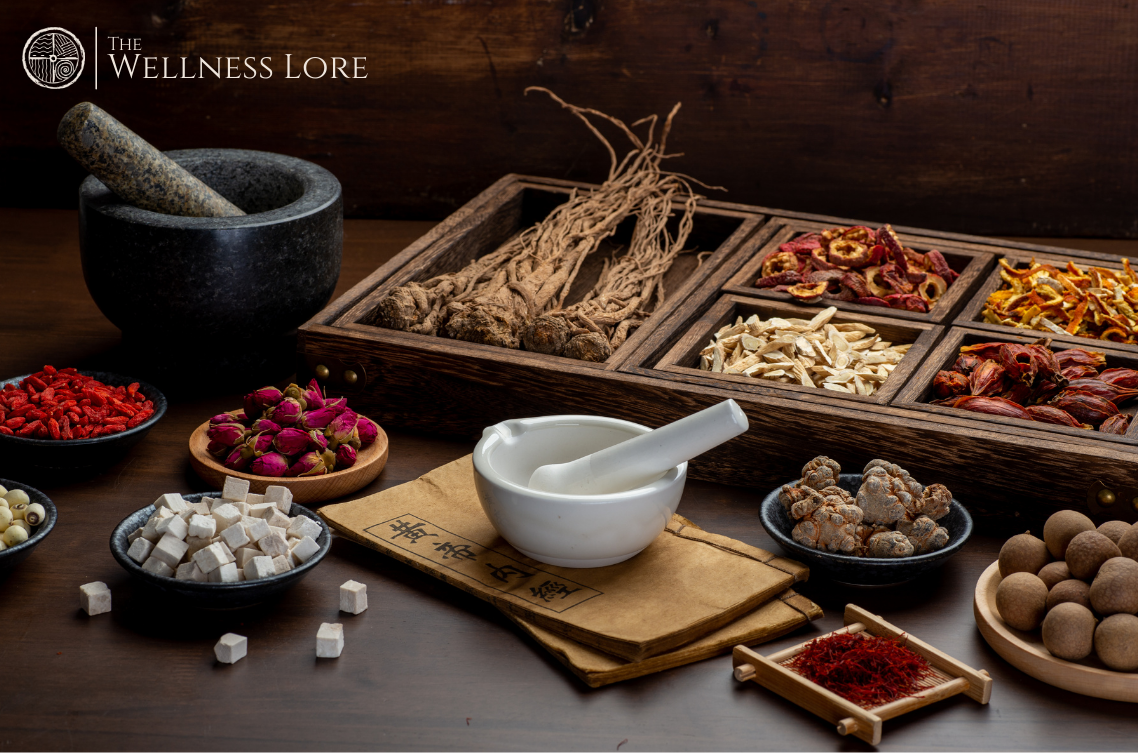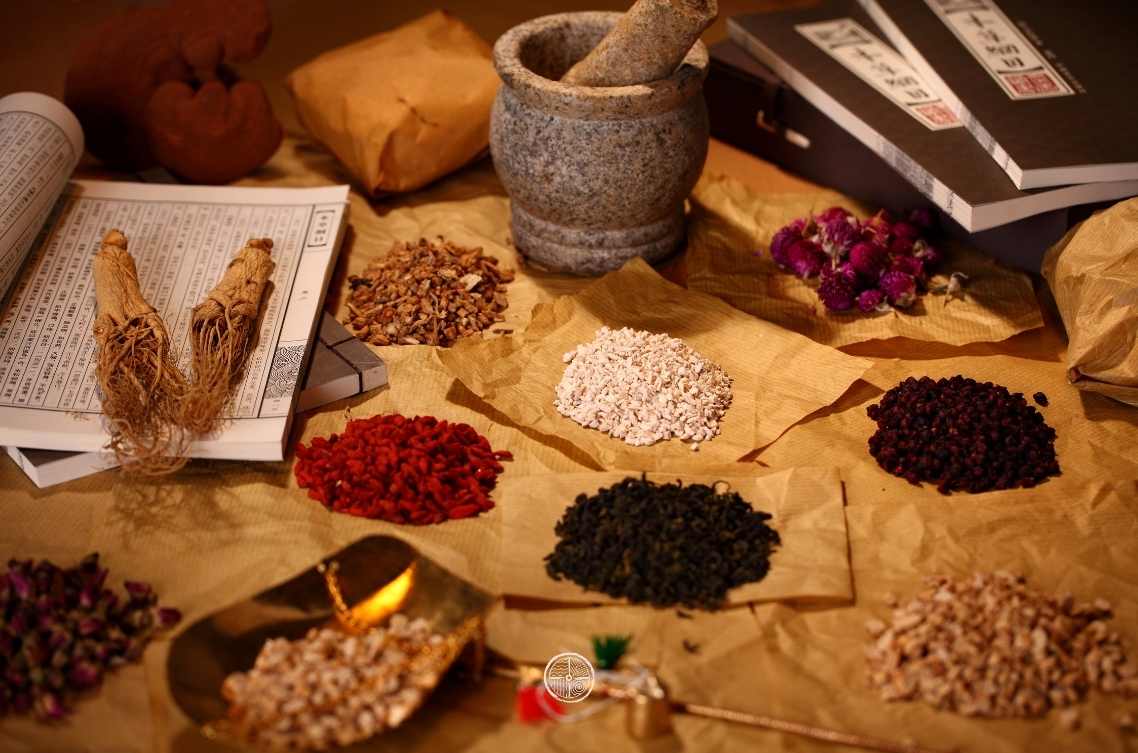Chinese Herbal Medicine

For centuries, cultures around the world have used traditional herbal medicines to treat a myriad of ailments. Today, with advances in science and technology like genomics and synthetic biology, the pharmacology, and mechanisms of herbal medicine are becoming more comprehensible in terms of modern medicine. Studies show the increasing use of herbal medicines for primary healthcare. Herbology is one such form of medicine derived from the traditional practice of medicine in China.
Herbology: The ancient Chinese herbal medicine
Chinese herbal medicine is an important aspect of Traditional Chinese Medicine (TCM), an ancient Chinese alternative to Western medicine. It works by balancing the yin and yang, facilitating the unhindered flow of qi (vital energy) through the body. After being scientifically tested and proven by hospitals and research centres, the first Chinese pharmacopoeia was published in 1953, with a total of 531 natural medicines and chemical drugs. The pharmacopoeia is revised every 5 years by the concerned authorities. Today, there are appropriate resources compiled in traditional Chinese herbal medicine, instructing the methods of preparation, selection, and identification of herbal medicines, and even the ideal time for obtaining various types of herbs. Although China remains the main consumer of herbal medicines, the use of traditional Chinese medicine practice has gained popularity in other parts of the world, including Europe and North America. For example, one of the top ten medicinal substances sold in Germany is Ginkgo Biloba, one of the oldest species of tree native to China. The extracts from its fan-shaped leaves are used to treat blood disorders, memory problems, eye care, and to improve cardiovascular functioning.
In traditional Chinese herbal medicine, an herbal formula consists of 4 main components – Principal, Assistant, Adjuvant, and Guiding herbs. While the principal herb is the most integral part of the medicine used to treat the main illness, the secondary herbs are used to treat minor symptoms of the illness. For example, the Si Jun Zi Tang recipe used to restore our intestinal functions is made of four types of herbs – namely Ginseng root (principal herb) for balancing the qi and strengthening the spleen and stomach, Atractyoldes (assistant herb) for the elimination of dampness, Poria (adjuvant herb) strengthens the effect of ginseng, and the final guiding herb licorice root invigorates the middle-jiao of the body.
Traditionally a tcm practitioner formulates dried herbs as per the patient’s prescription (customized) provided by the herbalist. People also use Chinese patent medicines (CPMs) that are ready-to-use formulations in tablet forms or oral solutions, approved by the National Drug Authority of China and akin to western drugs. Some of the top CPMs contain antiviral, antibacterial, anti-inflammatory, antipyretic, analgesic, anti-acute lung injury, anti-shock, immune regulation, and pulmonary function enhancement components. Originating from China, Kampo medicines are another form of prepared herbal formulas available in powder and tablet forms that are widely practised and integrated into Japan’s national healthcare system. Gaining worldwide popularity because of their evidence-based research studies, they are used to treat a variety of illnesses including hypertension-related disorders, gastrointestinal inflammation, and heart failure.
Herbs used in Chinese herbal medicine (Herbology)
From over 13,000 medicinal herbs and 100,000 medicinal recipes recorded in literature, some of the most commonly used traditional Chinese herbs are astragalus, Dong Quai, ginger, liquorice, Lycium barbarum (wolfberry), Panax ginseng, cinnamon, ephedra Sinica, peony, Rehmannia, rhubarb.
- Native to China, Astragalus is a perennial plant whose long roots contain antioxidants. They are used as an herbal supplement for allergies, the common cold, heart diseases, kidney diseases, and diabetes. It also contains beneficial plant compounds to enhance immune function and alleviate the side effects of chemotherapy.
- Dong Quai is another primary botanical used by Chinese herbalists. Commonly known as the ‘female ginseng’, it is widely used among women for the treatment of gynecological conditions such as irregular menstrual cycles, premenstrual syndrome (PMS), menopausal symptoms, and period cramps. The herb nourishes the blood and promotes healthy circulation.
- The health benefits of this herb are mainly attributed to two of its components namely gingerols and shogaols. Used as a spice and a medicinal plant, ginger is consumed in multiple ways. The soothing ginger tea is a favorite among the crowd. The beverage relieves nausea, alleviates menstrual discomfort, is good for blood pressure, and improves heart health by lowering blood pressure, preventing blood clots, lowering cholesterol, and improving blood circulation. Adding honey to ginger gives the best of both. The concoction of their antimicrobial, anti-inflammatory, and antiseptic properties aids in digestion, nasal congestions, and flu symptoms, and boosts your immunity.
- Another notable herb in TCM is the roots of an herbaceous perennial legume called the licorice or gancao in Chinese. Commonly used as a guiding herb, licorice is available in capsuled and liquid extracts. It tones the qi of the spleen and is beneficial to treat gastrointestinal problems and inflammation (including the prevention and treatment of ulcers). It is also effective against bacterial and viral infections like staph infections, strep throat, and skin problems due to diabetes. Having been used for medicinal properties for many years, the CFDA has approved 554 drugs containing liquorice.
- Among the many varieties of ginseng in the world, Panax ginseng is one of the most precious herbal medicines. Also called Korean ginseng, the herb has adaptogenic effects that stimulate resistance during stress and are used to treat depression, memory skills, concentration, and cognition. One of the highly researched types of ginseng, the ginsenosides component in Panax ginseng stimulates insulin production in the human pancreas and is therefore used to treat conditions associated with diabetes.
- Used in yin deficiency, Lycium barbarum (also known as wolfberry or goji berry) is another widely used Chinese herbal medicine. Rich in bioactive properties, antioxidants, and minerals like potassium, sodium, phosphorus, iron, and calcium among others, it is beneficial for the immune system, nourishes the eyes, liver, and kidneys, and slows signs of ageing. Available in dried forms, they can be used in your daily cereals, yoghurt, salads, and smoothies for general health and wellness
- One of the most ancient spices in common use, cinnamon is known for its taste, aroma, and its medicinal benefits equally. Cultivated in different regions of the world, cinnamon originated in Southern China and is available in small pieces of bark as well as in powdered forms. Noted to have antioxidant, anti-inflammatory, antimicrobial, and antifungal properties cinnamon is used to treat skincare issues like acne, wrinkles, skin brightening, discolouration, and eczema. The anti-inflammatory properties of cinnamon reduce the risk of developing heart disease, which is the leading cause of death worldwide. Studies also show that they contain cardiovascular disease-lowering compounds.
- The two alkaloid components of Ephedra Sinica (Ma Huang in TCM) namely ephedrine and pseudoephedrine have been formulated into a modern pharmaceutical drug to treat asthma and sinus congestion. Available in dried and liquid form, Ephedra Sinica is also prescribed for cough, bronchitis, allergic rhinitis, nasal congestion, and allergies.
- Peony (sho yu in Chinese) is a flowering plant frequently used in TCM as well as in the traditional medicines of Korea and Japan. There are two species of peony namely the white peony, traditionally known as ba isho, and the red peony called the chi shao. Each of them possesses unique properties and medicinal benefits. The phytoestrogens in white peony have been proven to be effective for females with menopausal hot flushes (MHF), while the paeoniflorin component increases probiotic bacteria in the gut improving your gut health. Slightly cool in nature, the roots of red peony stimulate better blood circulation as well as reduce liver heat. Sho yu is also used with other herbs like liquorice and tang-kuei to optimize their treatment effects.
- Used in herbal formulas like Ma Zi Ren Wan which is used to treat difficult bowel movements, the rhizome, and roots of Rhubarb are important herbal medicines in TCM. An important medicinal laxative, some of the medical effects of rhubarb include inhibition of fibrosis, regulation of the gut flora, inflammation reduction, and protection of intestinal barriers.
Chinese herbal medicine is used to treat a variety of ailments and enhance general health and well-being. With increasing consumer awareness of the therapeutic effects of complementary and alternative medicines which includes herbal medicine is on the rise.
More Recent Stories



